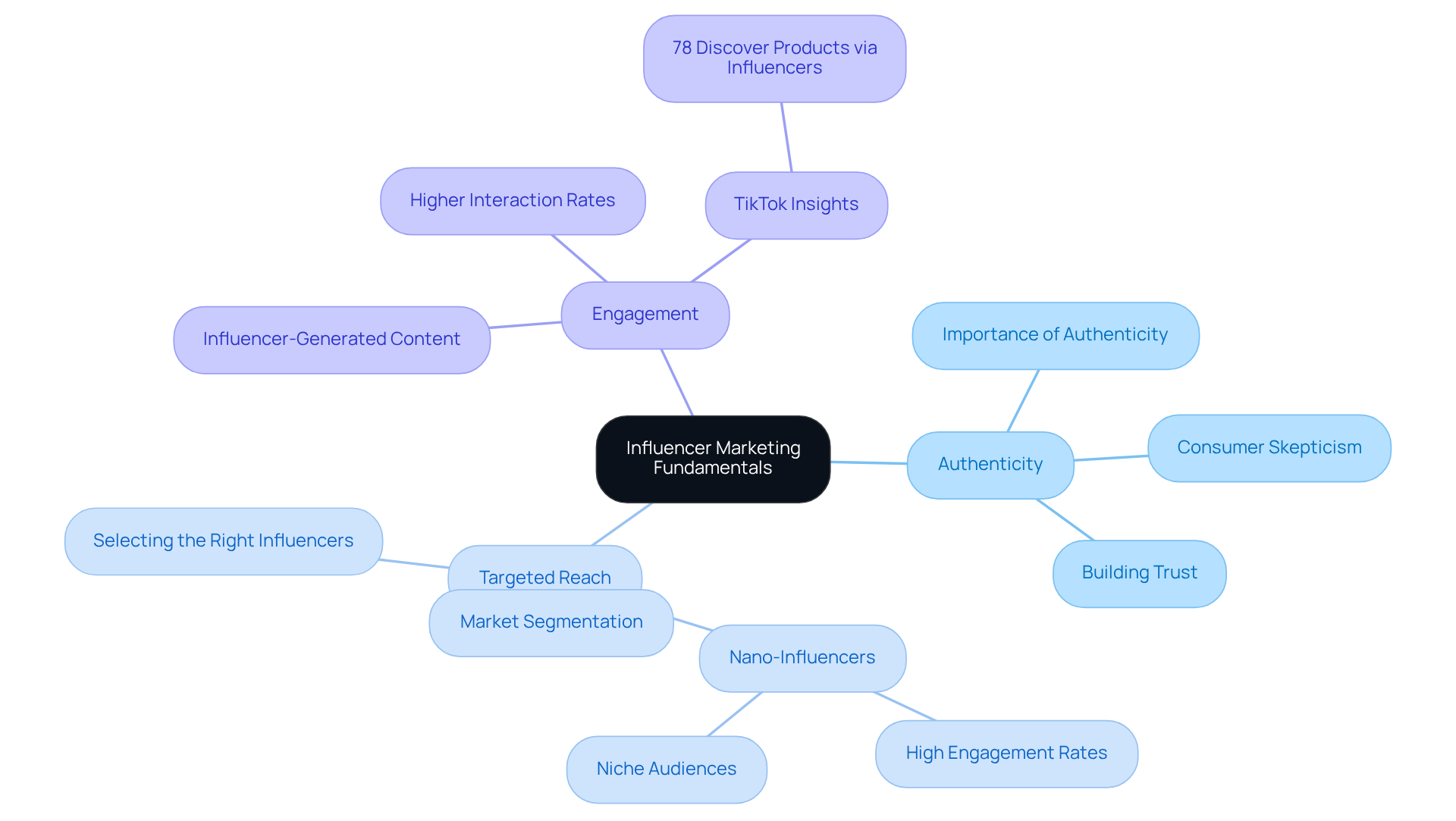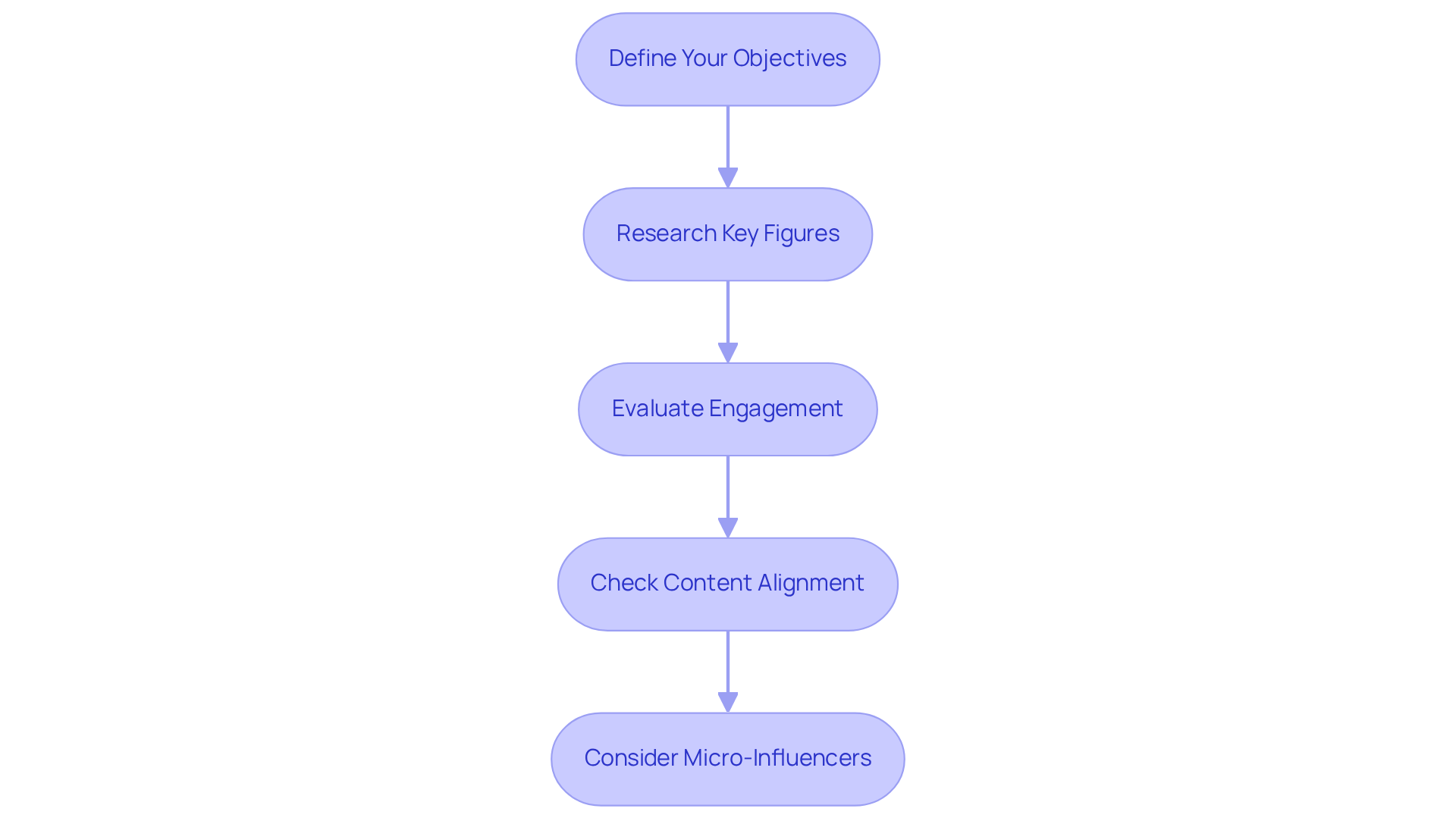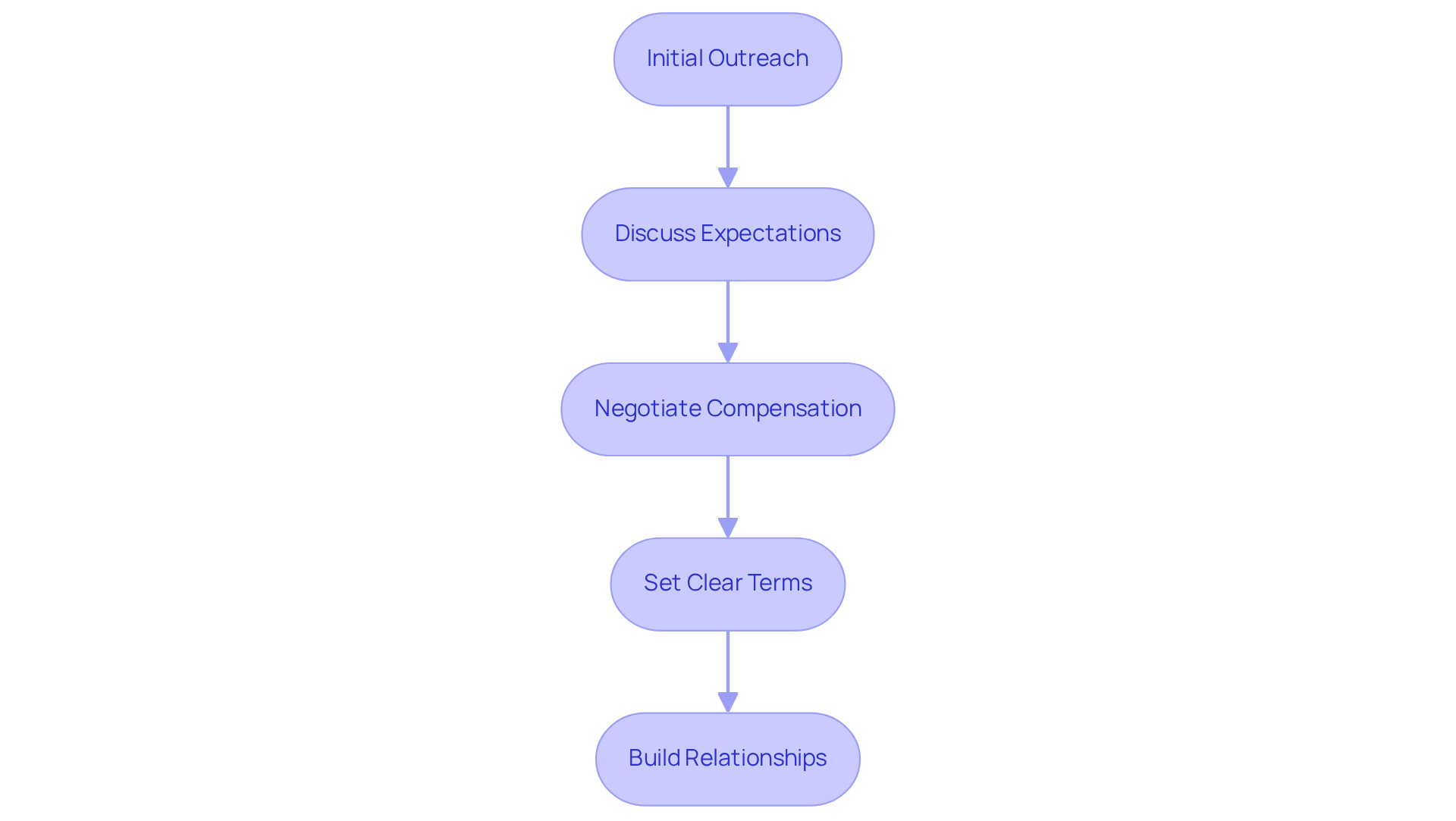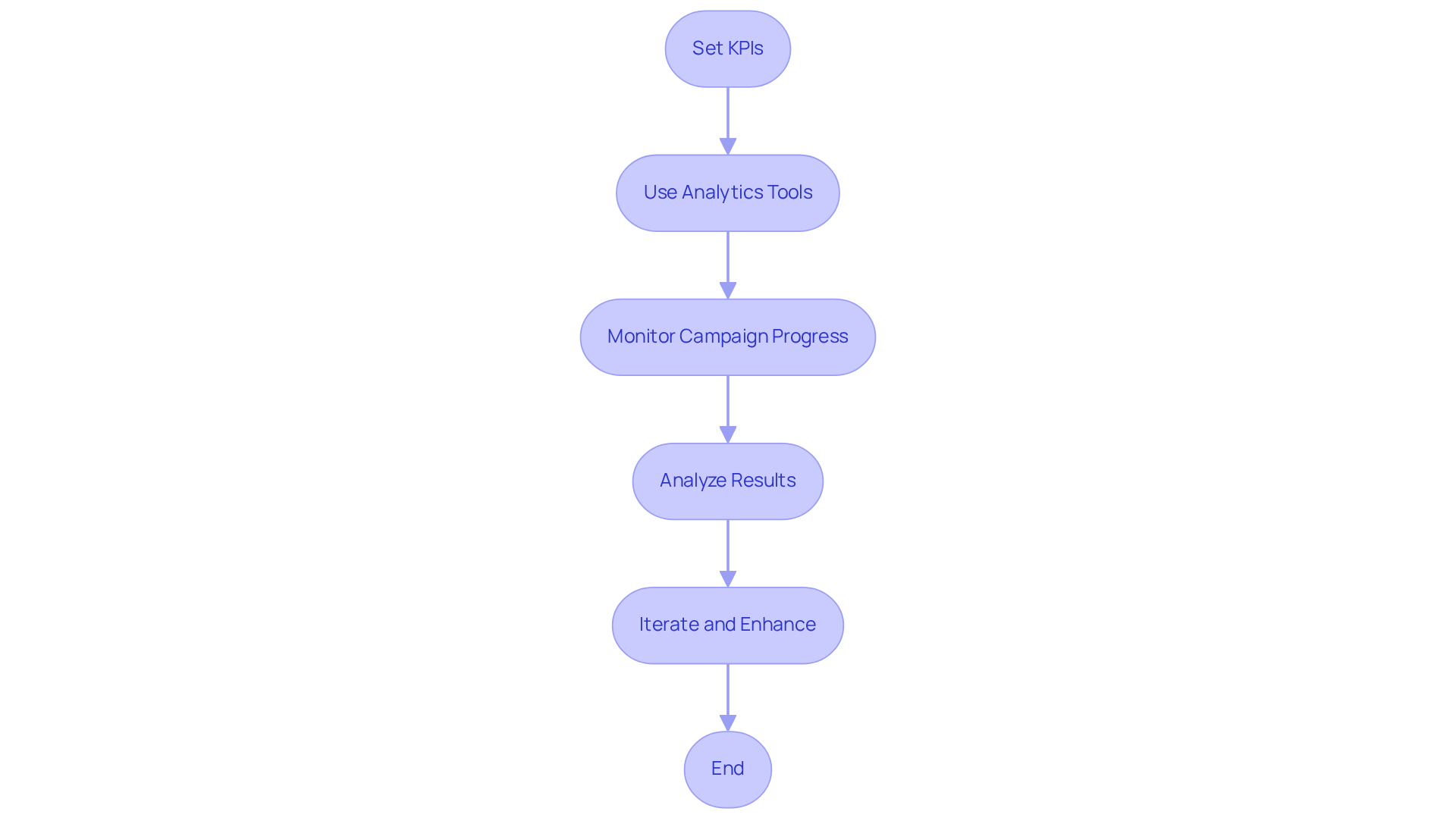
Introduction
Influencer marketing has emerged as a powerful strategy for brands aiming to connect authentically with their audiences in today’s crowded digital landscape. By leveraging the influence of individuals with dedicated followings on social media, brands can foster genuine engagement and drive impactful results. However, navigating the complexities of selecting the right influencers, establishing meaningful partnerships, and measuring success presents a significant challenge.
How can brands effectively harness influencer marketing to enhance visibility while building lasting relationships with their target consumers? This question is crucial as it invites brands to rethink their strategies and consider the profound impact of authentic connections.
Understand Influencer Marketing Fundamentals
Influencer promotion demonstrates how to use influencer marketing as a powerful strategy that leverages the reach of individuals with substantial followings on social media platforms to effectively promote products or services. This approach marries traditional marketing methods with the dynamic landscape of contemporary social media, illustrating how to use influencer marketing to connect with targeted audiences in a genuine and impactful way.
-
Authenticity is paramount in this realm. Influencers are often perceived as relatable and trustworthy figures, making their endorsements significantly more impactful than traditional advertisements. As consumer skepticism towards corporate messaging continues to rise, brands that learn how to use influencer marketing can cultivate stronger connections with their audience.
-
Targeted Reach is another critical advantage. Brands can learn how to use influencer marketing by selecting influencers whose followers align with their target demographics to effectively penetrate specific market segments. For example, campaigns featuring nano-influencers-those with fewer than 10,000 followers-often yield high engagement rates due to their niche audiences.
-
Engagement levels also soar with influencer-generated content, which typically garners higher interaction rates compared to brand-produced material. Studies reveal that 78% of TikTok buyers discover products through creators, underscoring the efficiency of this promotional approach.
The importance of genuineness in social media promotion cannot be overstated. Brands that prioritize authentic partnerships and encourage influencers to engage sincerely with their products can sidestep the pitfalls of inauthenticity, which can undermine both product appeal and influencer credibility. As we approach 2025, the impact of social media promotion on company authenticity will continue to evolve, making it essential for businesses to adapt their strategies accordingly.

Identify and Select Suitable Influencers
To identify and select suitable influencers, follow these essential steps:
-
Define Your Objectives: What do you aim to accomplish with your marketing campaign? Whether it’s raising awareness, boosting engagement, or driving sales, clarity in your objectives is crucial.
-
Research Key Figures: Utilize social media analytics platforms to pinpoint influencers who resonate with your brand values. Look for those with a following that aligns with your target audience, ensuring a meaningful connection.
-
Evaluate Engagement: Don’t just focus on follower counts. Assess engagement rates, audience demographics, and the authenticity of interactions. This deeper analysis reveals the true influence of potential advocates.
-
Check Content Alignment: Ensure the influencer's content style and messaging align with your company's identity. Consistency in branding is key to maintaining credibility.
-
Consider Micro-Influencers: Often, micro-influencers-those with smaller but highly engaged followings-can deliver better ROI. Their niche audiences and higher engagement rates can significantly enhance your campaign's effectiveness.
By thoughtfully selecting advocates, companies can understand how to use influencer marketing to forge deeper relationships with their audience, ultimately leading to more impactful marketing outcomes.

Engage and Negotiate with Influencers
Engaging and negotiating with influencers is a strategic process that involves several key steps:
-
Initial Outreach: Begin by reaching out to key individuals with a personalized message that conveys genuine admiration for their work. Explain how their values align with your brand. This approach sets a positive tone for the partnership.
-
Discuss Expectations: Clearly outline your campaign goals, deliverables, and timelines. Encourage open dialogue; individuals with deep knowledge of their audience can significantly enhance campaign effectiveness.
-
Negotiate Compensation: Address payment structures, whether through flat fees, commissions, or product exchanges. Transparency about your budget is crucial, but it’s equally important to respect the influencer's value and expertise. MediaNug's NugVerse empowers creators to earn fair compensation for every project, allowing them to create on their terms and showcase their unique styles. Standard commission percentages typically range from 10-20%, and offering performance-oriented incentives can further encourage deeper connections with your company.
-
Set Clear Terms: Draft a detailed contract that specifies content usage rights, exclusivity clauses, and other essential details to prevent misunderstandings. Clear communication about these terms fosters trust and ensures both parties are aligned.
-
Build Relationships: Prioritize long-term relationships over one-off transactions. This strategy not only leads to more authentic promotions but also enhances overall campaign effectiveness. Frequent check-ins and transparent communication can help sustain these connections, making key individuals feel appreciated and involved in your company's success. As Kelly Ehlers from The Evoke Agency states, "When trust and sustained engagement are the priority, these relationships offer unparalleled value."
By following these steps, companies can cultivate positive and productive partnerships with influencers, ultimately driving better results and fostering loyalty.

Measure and Optimize Influencer Marketing Performance
To effectively measure and optimize influencer marketing performance, follow these essential steps:
-
Set KPIs: Establish key performance indicators (KPIs) such as engagement rates, reach, conversions, and return on investment (ROI). These metrics serve as benchmarks for evaluating campaign success. For instance, companies often monitor a ROAS of 4.5, indicating they receive $4.50 for every dollar invested in campaigns. This highlights the efficiency of their promotional efforts.
-
Use Analytics Tools: Leverage advanced analytics tools like Google Analytics, Instagram Insights, TikTok Analytics, and Influencity to track performance metrics. These platforms provide valuable insights into impressions, reach, and audience engagement, enabling companies to make informed decisions.
-
Monitor Campaign Progress: Regularly assess campaign performance throughout its duration. This real-time monitoring allows for timely adjustments based on data trends, ensuring that campaigns remain aligned with objectives.
-
Analyze Results: After the campaign, conduct a thorough analysis of the collected data to identify successful strategies and areas for improvement. Look for patterns in engagement and conversion rates to understand what resonates with your audience.
-
Iterate and Enhance: Utilize insights from your analysis to refine future promotional strategies. Focus on enhancing elements that drive engagement and conversions, ensuring continuous improvement in your campaigns.
By consistently assessing and refining performance, brands can significantly boost their promotional efforts, leading to enhanced outcomes and a stronger return on investment. A robust measurement framework is essential for understanding how to use influencer marketing effectively, as it provides clarity on what works and what doesn’t, ultimately guiding strategic decisions.

Conclusion
Influencer marketing emerges as a pivotal strategy for brands aiming to forge authentic connections with their target audiences. By harnessing the credibility and extensive reach of influencers, companies can adeptly navigate the complexities of modern marketing, fostering genuine relationships that resonate deeply with consumers. This approach not only amplifies brand visibility but also cultivates trust - an essential factor in today’s competitive marketplace.
Key strategies for successful influencer marketing have been meticulously outlined throughout this article. Grasping the fundamentals of influencer marketing, selecting the right influencers, engaging them effectively, and measuring performance are crucial steps in crafting impactful campaigns. Authenticity and targeted reach stand out as vital elements that can significantly sway engagement and conversion rates. Moreover, the significance of nurturing long-term relationships with influencers cannot be overstated; these connections yield more fruitful and trustworthy promotions.
As brands delve into the expansive potential of influencer marketing, embracing these best practices becomes imperative. The landscape is in constant flux, and those who adapt their strategies to prioritize genuine engagement and measurable outcomes will undoubtedly thrive. It is essential for businesses to not only implement these tactics but also to continuously refine their approaches based on performance insights. By doing so, brands can ensure they remain relevant and effective in their marketing efforts, ultimately driving growth and success in an increasingly competitive environment.
Frequently Asked Questions
What is influencer marketing?
Influencer marketing is a strategy that leverages the reach of individuals with substantial followings on social media to promote products or services, combining traditional marketing methods with contemporary social media dynamics.
Why is authenticity important in influencer marketing?
Authenticity is crucial because influencers are seen as relatable and trustworthy figures, making their endorsements more impactful than traditional advertisements. This authenticity helps brands build stronger connections with their audience.
How can brands achieve targeted reach through influencer marketing?
Brands can achieve targeted reach by selecting influencers whose followers align with their target demographics, allowing them to effectively penetrate specific market segments. For instance, campaigns with nano-influencers often yield high engagement rates due to their niche audiences.
What are the engagement levels like for influencer-generated content?
Influencer-generated content typically garners higher interaction rates compared to brand-produced material. Studies show that 78% of TikTok buyers discover products through creators, highlighting the effectiveness of this promotional approach.
How can brands maintain genuineness in their influencer partnerships?
Brands can maintain genuineness by prioritizing authentic partnerships and encouraging influencers to engage sincerely with their products, which helps avoid inauthenticity that can undermine product appeal and influencer credibility.
What trends are expected in social media promotion as we approach 2025?
As we approach 2025, the impact of social media promotion on company authenticity is expected to evolve, making it essential for businesses to adapt their strategies to maintain relevance and effectiveness.





